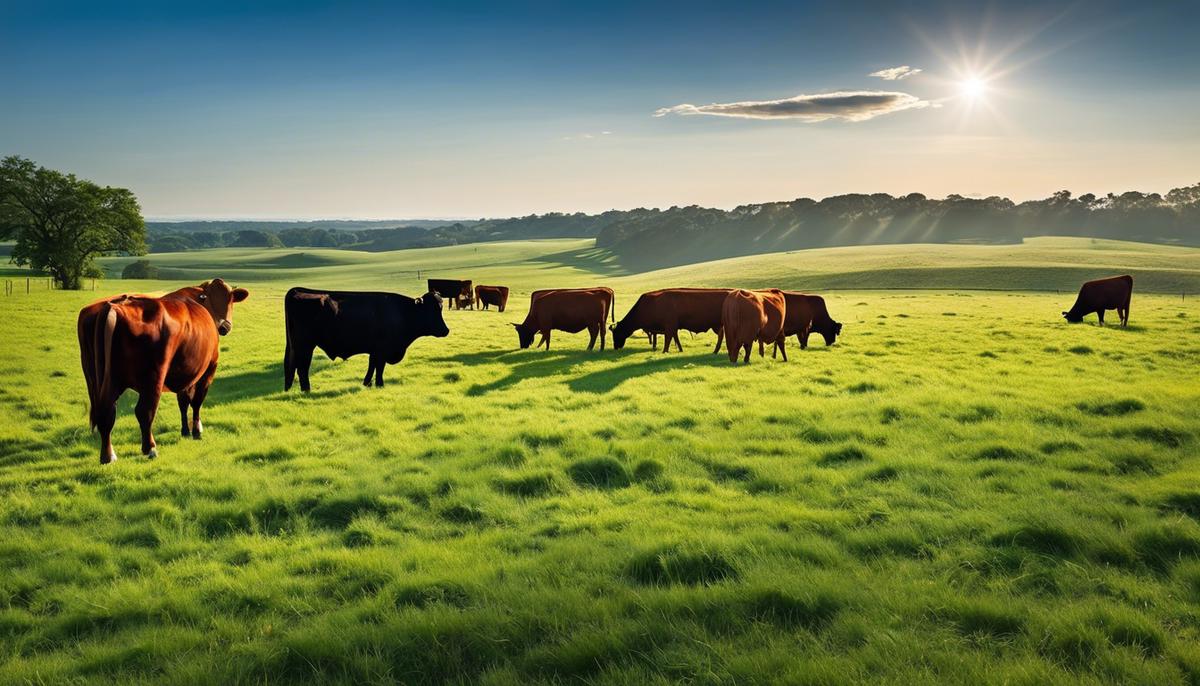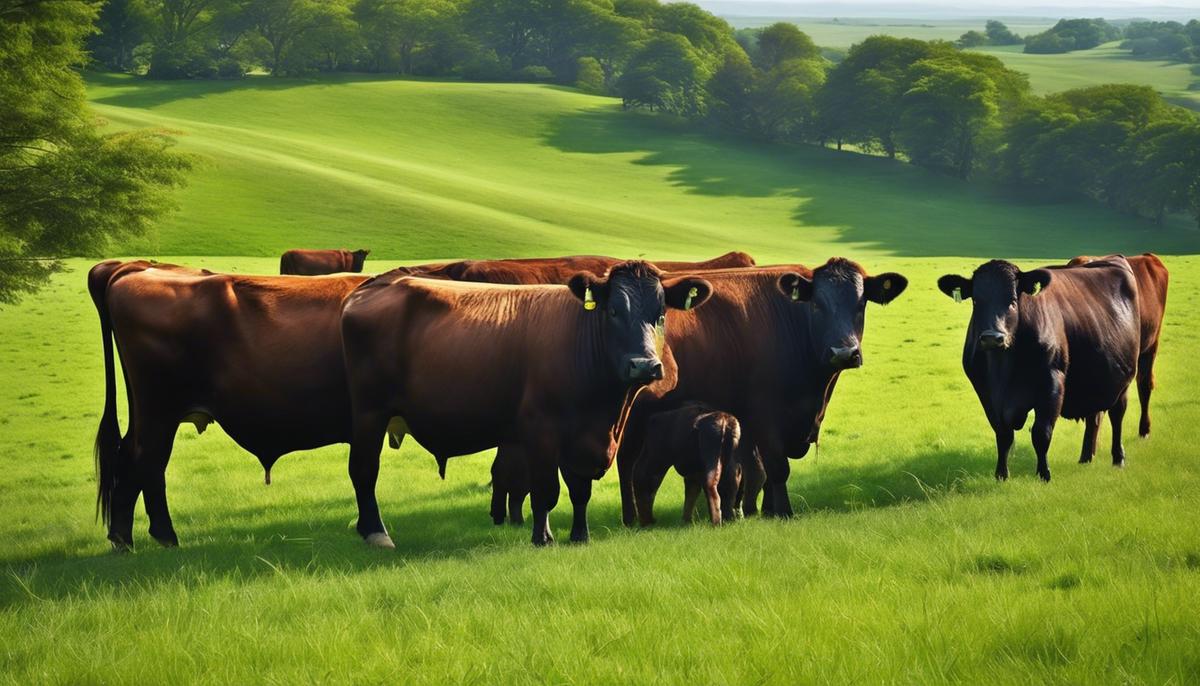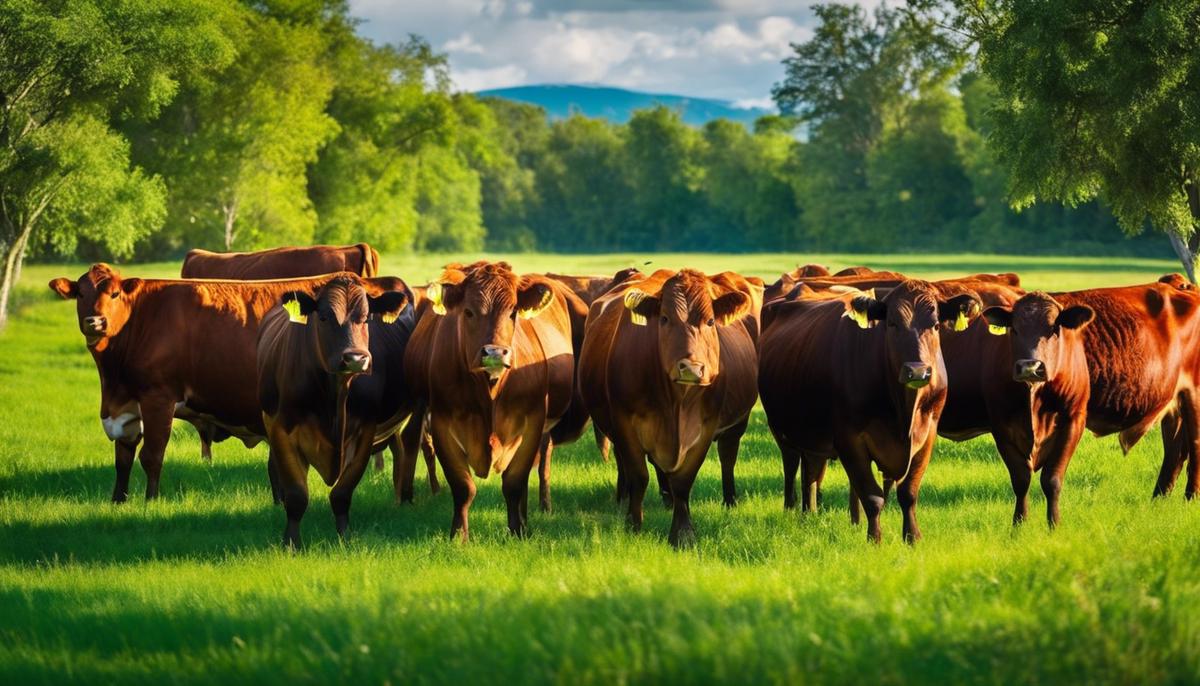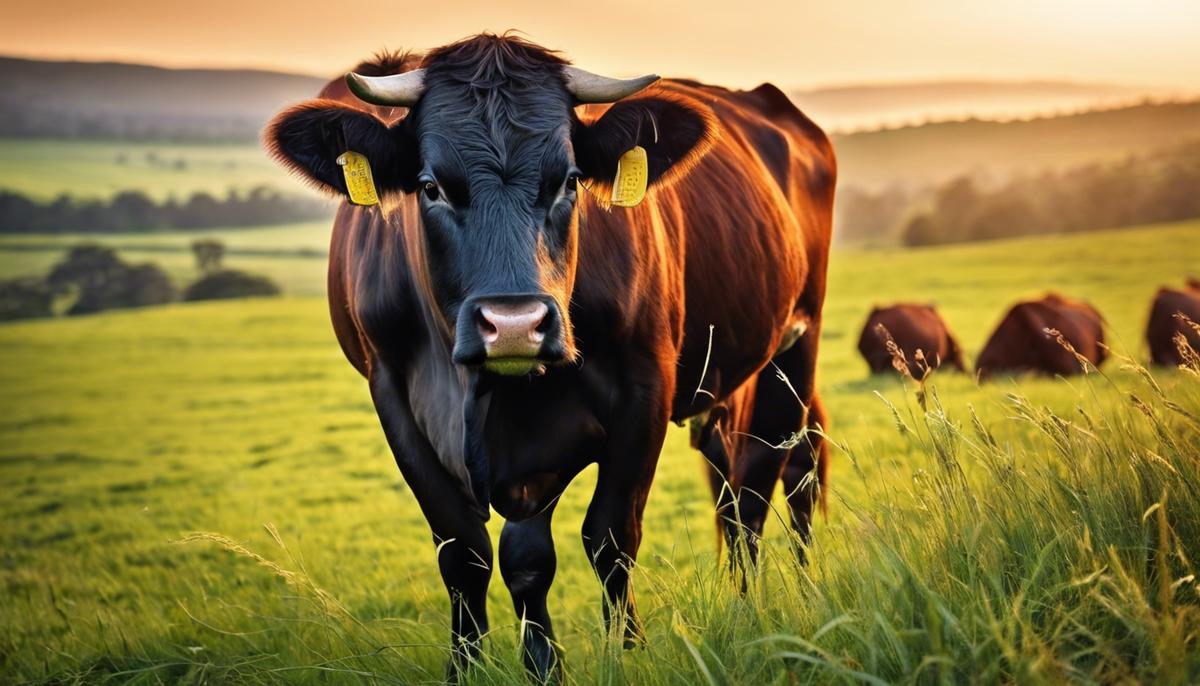
Beef cattle | Raising and Feeding
Description: When exploring the intricacies of beef cattle raising and feeding, it becomes evident that these processes are not only a crucial part of agriculture but also of human civilization. As one begins to understand the complexities of these farming practices, a fascinating tapestry of knowledge spanning genetics, nutrition, husbandry, environment, and economics reveals itself. The journey to unravel these mysteries takes us through different breeds of cattle and their unique characteristics, an in-depth dive into ruminant nutrition and optimized feeding strategies, forward-looking husbandry practices, and a study on how drivers within the environment and market forces shape the industry. But most importantly, it will deeply immerse us in the effort to marry agricultural profitability with environmental sustainability. The intricate interplay between breed selection and genetic selection commands a significant role within the realm of beef cattle farming. These two elements not only influence productivity, but also the quality of the output and adaptability of cattle to various environmental conditions. A clear comprehension of such complex dynamics is pivotal in effective farm management strategies. Breed selection hinges on the concept of choosing cattle with physical and biological characteristics that match the intended purpose – in this case, beef production. Breeds vary considerably in size, growth rate, and meat quality such as marbling and tenderness. Some breeds, Angus for instance, are coveted for the quality of their beef while others like Charolais are distinguished by their rapid growth and hefty weights. Meanwhile, genetic selection operates on a more nuanced level. It draws on the principles of genetics to enhance or suppress certain traits within a breed, with the aim of fostering improvement over successive generations. Such a process requires a more in-depth understanding of each animal’s genetic makeup and the interplay of these complex traits. Underpinning both breed and genetic selection is the enduring quest for efficiency. For beef-cattle farmers, efficiency doesn't merely denote producing more pounds of beef; rather, it encompasses managing resources prudently, reducing costs, and improving the quality of the product. Balancing these elements can sometimes feel like a high-stakes juggling act. How, then, does a farmer make such nuanced decisions? Performance records are key, providing objective data on various traits such as growth rate, weight, and carcass quality. Modern technological advancements – genetics and genomics in particular – have allowed for even greater accuracy and precision in selection procedures. Interestingly, breed and genetic selections are not isolated choices. Savvy beef-cattle farmers are increasingly integrating both strategies in a holistic approach. Certain combinations have proven advantageous, allowing farmers to capitalize on the strengths of one breed or line while compensively managing its weaknesses with strategic genetic selection. However, caution is essential. Pursuit of a particular trait should not compromise others. This balance helps maintain the overall hardiness and adaptability of the animals - vital attributes considering the inherent unpredictability of environmental conditions and market forces. Indeed, the symbiosis of breed and genetic selection is a fascinating journey. Uncovering its intricacies imparts us with the knowledge to better direct the future of beef cattle farming. Undeniably, it is a blend of fine-tuned science, artful selection, and seasoned wisdom. As a dedicated steward of livestock sciences, one observes an undeniable interdependence between the realm of nutrition and the productivity of beef cattle farming. Offering a clear and meticulous understanding of this interplay allows us to unlock potential keys to improved and efficient beef production. Well-practiced and innovative feeding strategies hold a quintessential role in the advancement of this agricultural sphere, granting superior livestock health, robust growth, and improved productivity potential. Emphasizing Nutritional Quality: The Fundamental Pillar Quality nutrition is the cornerstone upon which all efficient beef cattle farming is built. Optimizing the feed constituents addresses the nutritional requirements of the cattle, thereby fueling healthy growth and, subsequently, robust productivity. The interlinked triad of nutrition that is pivotal to this includes energy, protein intake, and mineral balance, which should cater to the individual health stages and growth needs of the cattle. Innovations in Feed Utilization Farming research has made remarkable strides towards identifying how best to utilize the feed given to beef cattle. Introduction of digestibility enhancers and utilizing high-energy, low-bulk feeds have played a crucial role in harnessing greater efficiencies. Additionally, progressive feeding techniques such as Total Mixed Ratio (TMR) ensure balanced nutrition, potentially improving feed conversion rates and reducing fitness issues, thereby amplifying cattle productivity. Reinforcing Health: The Vaccination Protocol Notably, vaccination protocols and preventive health measures form an integral part of innovative feeding practices. These strategies are diligently applied to protect the cattle from infections and diseases that could compromise their growth and productivity. They ensure the robust immune response of the animals, creating an environment conducive to optimal productivity. Embracing Sustainable Practices Given the variable and often unpredictable pressures from environmental conditions and market forces, sustainable feeding strategies offer a valuable avenue for resilience. By efficiently using locally available resources and reducing the carbon footprint, these strategies significantly contribute to the long-term, sustainable success of beef cattle farming. Techniques such as rotational grazing or the integration of mixed farming systems exemplify this approach, combining quality nutrition with environmental conscientiousness. Conclusion: Embracing Innovations in Feeding Practices Inarguably, maintaining a grasp on the pulse of nutritional necessities and applying innovative feeding practices forms an indispensable part of responsible and efficient beef cattle farming. As custodians of these livestock sciences, embracing these advancements can thus pledge sustained viability and enhanced productivity in this vital industry. Further exploration in relation to the benefit of these nutritional innovations holds immense promise for the future of beef cattle productivity. Unarguably, this marriage of nutritional science and agriculture forms a key area of continued exploration, ensuring the ceaseless vitality of our shared agricultural heritage. Massive strides have been made in the fields of genetics and nutrition to optimize beef cattle farming, however, husbandry practices remain a cornerstone in the coherent approach to both animal welfare and productivity. This recognition prompts an examination of practical cow-calf management strategies, sanitation protocols and efficient housing systems. Cow-calf management is at the forefront of impactful husbandry duties. With prudent calf involvement such as weaning and castration, efficiency improves while ensuring the well-being of cattle. Introducing effective weaning methods, for instance, such as two-step weaning, can diminish stress-related behavioral alterations and possible weight loss in the process. Meanwhile, castration, pivotal for meat quality and aggressive behavior control, should be executed at the youngest permissible age, abiding by the American Veterinary Medical Association guidelines. Broadly, sanitation is the unsung hero among husbandry practices. Observing stringent hygiene measures, including regular cleaning of barns and other areas, can reduce the chances of pathogen builds up. Protection against diseases is further enhanced by good biosecurity. This involves facilitating isolation for incoming or susceptible cattle, rubber footwear for handlers, and disinfection stations at farm exits. Proactive monitoring and immediate treatment of sick animals also form an integral part of good hygiene practices. Accommodation is entire more than simple shelter provision for cattle. Housing systems should be designed to exploit natural behaviors and environmental adaptability. Ventilated, comfortable barns contribute to improved cattle health, growth, and carcass merit. Pasture systems, with plenty of space for the cattle to act out their natural instincts and suitable shelters against environmental extremes, can enhance cattle welfare. In essence, a molding of housing and pasture systems is often the optimal approach. While environmental enrichment has long been crucial in the aquaculture and poultry sectors, it is a comparatively fledgling concept in beef cattle farming, yet incredibly promising. Improved animal welfare, as a result of enriched environments that cater to animal's inherent behavioral needs, usually manifests in heightened productivity. This can be achieved by simple inclusions like grooming brushes and resting areas in the living space. Training, although frequently underestimated, forms a crucial pillar in husbandry practices. Approachable animals are less stressed, ensuring higher output and improved safety for handlers. Training can be as foundational, yet significant, as teaching cattle to be comfortable around humans, or can extend to more complex behaviors like loading onto transport vehicles. Importantly, humane handling during these training periods is paramount. In the final analysis, husbandry practices play a non-negotiable role in beef cattle productivity and welfare. Besides genetic selection strategies and sophisticated nutritional innovations, judicious cow-calf management, diligent hygiene practices, efficient housing designs, environmental enrichment, and consistent training sessions coalesce into the intricate art of husbandry practices that strive towards a tremendous goal- optimizing both animal welfare and productivity. The intertwining relationship between a cattle's well-being and productivity only underscores the imperative role of husbandry in beef cattle farming. Grazing is a critical facet of beef cattle farming - creating a symbiotic relationship between the land and the cattle. However, it is vital that a comprehensive and efficient waste management system is a component of this practice. The accumulation of waste, predominantly made up of manure, if left unchecked, can result in environmental pollution. Nitrogen and phosphorus - two primary components of cattle manure, can contaminate water sources – both surface and underground, consequently disrupting marine and aquatic life and ecosystems. Promoting waste-to-energy systems, such as biogas production, can significantly offset the environmental impact. This system captures the methane released during the decomposition of organic waste and converts it into a renewable energy source, reducing greenhouse gas emissions. Moreover, it leaves behind an organic residue which can be used as a nutrient-rich fertilizer, providing a closed-loop system to recycle nutrients and energy. Precision farming technologies have been harnessed extensively in crop production, but their use in beef cattle farming is still gaining traction. Tactics such as Livestock Identification and Traceability Programs use electronic tags, facilitating real-time tracking of individual animal performance - primarily to monitor health, reproduction, and productivity. This not only assists in early disease detection and prompt intervention, but also helps in fine-tuning dietary inputs and managing stocking rates, contributing to enhanced productivity and sustainability. Radio Frequency Identification (RFID) and Global Positioning Systems (GPS) are other indispensable tools in precision livestock farming. RFID tags prove to be of immense value in curtailing the overuse of antibiotics, which directly affects the environment due to the risk of contributing to antibiotic resistance. Targeted treatments and vaccinations enabled by RFID tags serve to minimize this risk. GPS enables satellite-control grazing, optimizing pasture management, and reducing soil erosion. Finally, strengthening peer-to-peer farmer networks and robust extension services serve as vital conduits for knowledge transfer. Learning from the successes and failures of other farms can drive the adoption of best practices, improving overall sustainability. Furthermore, collaborations with research institutions can help develop innovative solutions that reconcile the dual objectives of productivity and environmental sustainability. Time and again, agriculture has proven itself to be a resilient sector, continuously innovating to meet an ever-changing array of challenges. Exploring the intersection of tradition and technology, beef cattle farming can chart a path towards productivity and environmental sustainability. The coupling of traditional wisdom and scientific insights will undoubtedly unlock future advancements, shaping a sustainable and productive future for beef cattle farming. Moving into the realm of financial considerations, the economic aspects of beef cattle farming cannot be overlooked. Farmers and ranchers need to be as conscious of dollars and cents as they are of herd health and breeding cycles. Economic considerations affect every part of the farm, from maintenance and feeding to breeding and selling. The fixed and variable costs associated with beef cattle farming are many and complex. Fixed costs like land investment, housing, and equipment can add up significantly. While variable costs - those such as labor, feed, veterinary charges, and transportation - fluctuate with the size of the herd and the market. Understanding these costs and developing suitable financial strategies is crucial to the economic health of the farm. Crucially, the profitability of beef cattle farming hinges largely on the quality and price of the beef produced, which in turn relies on careful management of nutrition, breeding, and husbandry practices. Market prices can be unpredictably volatile, impacted by global trade, national policies, consumer trends, and more. Stakeholders must therefore employ astute market analysis and flexible strategies to navigate these uncertainties and continue producing superior-quality beef reliably and efficiently. Beef cattle farming also has a far-reaching economic influence on local economies. It provides jobs, supports rural communities, and contributes to the Gross Domestic Product (GDP). In fact, the beef industry is a substantial component of the agricultural sector in many countries, underlining its importance beyond mere individual profitability. Added to that, the increasing demand for sustainable beef farming has led to innovative financial models and government policies. Cap and trade systems are being investigated to put a price on greenhouse gas emissions, giving farmers an incentive to reduce their own emissions, while agri-environment schemes provide payments to farmers for managing their land and cattle in ways that benefit the environment. The economic aspects of beef cattle farming are also affected by emerging technologies. The ubiquity of precision farming technologies such as RFID and GPS not only improves efficiency and animal health, but may also open up new revenue streams. For instance, data gathered from sensor tech on cattle could be valuable to companies developing farm tech or environmentally-friendly practices. In conclusion, the economic implications of beef cattle farming are profound, affecting decisions made on the farm, reaching to local economies, and even impacting environmental policies. Understanding the financial and economic facets, employing adaptive strategies, and leveraging new technologies are paramount to the economic viability and sustainability of beef cattle farming. This is where the fusion of knowledge, passion, and unwavering dedication to the industry make all the difference. We look toward an exciting future where advanced technologies, sustainable practices, and economic prosperity go hoof in hoof in beef cattle farming. Stepping back, it becomes apparent that the realm of beef cattle farming is a complex yet enriching one - interlinking genetics, feeding strategies, and environmental and economic considerations. A better understanding of these domains helps us discern the farmers’ struggle to raise healthy, productive cattle while remaining economically viable and environmentally responsible. Armed with this knowledge, it is our hope that the information provided will foster a new respect for this elaborate industry that seems to so seamlessly balance a multitude of factors. It also underscores the importance of continuous learning and advancement in farming practices to ensure the sustenance of this critical facet of agriculture for generations to come. Ensuring the health and productivity of beef cattle begins with a foundational understanding of their dietary needs. For cattle to thrive, they require a balanced intake of proteins, carbohydrates, fats, vitamins, minerals, and water. Each of these components plays a crucial role in their growth, reproduction, and overall health. As responsible caretakers, it's imperative to delve into the array of feed options available, including pasture grasses, hay, silage, grains, and specialized supplements, and to discern their quality and applicability to cattle at varying life stages. Feeding strategies are not a one-size-fits-all but rather a complex system tailored to the unique demands of beef cattle which can shift with seasons, growth phases, and individual health needs. Gaining insight into the proper feeding schedules, seasonal dietary adjustments, and precise calculation of feed portions ensures that nutritional requirements are met in the most efficient manner possible. The health and productivity of beef cattle are contingent upon adherence to specific nutritional requirements. Thorough understanding of these requirements permits informed management strategies that yield livestock of superior vitality and economic value. Herein, an analytical discourse on the quintessential nutrients for beef cattle is presented to facilitate informed decision-making amongst those charged with bovine welfare and husbandry. Energy: Paramount among nutritional needs, energy is largely derived from carbohydrates consumed by cattle. The primary components include cellulose and starches, with energy needs varying according to age, weight, physiological demands, and environmental stressors. Proteins: The building blocks of cellular repair and growth, proteins are indispensable for tissue synthesis, hormonal balance, and vital physiological processes. The quality and quantity must correspond to growth phases, reproductive status, and milk production levels. Amino Acids: Beef cattle have the ability to synthesize several amino acids intrinsically; however, essential amino acids such as lysine and methionine must be provided through diet. These are critical for optimum growth and development. Minerals: The metabolic functions and skeletal integrity of cattle hinge on a balanced mineral supply. Macrominerals like calcium, phosphorus, magnesium, and sodium are required in discernible amounts, whereas microminerals such as zinc, copper, selenium, and iodine are necessary in trace quantities albeit with profound physiological implications. Vitamins: These organic compounds, although necessitated in minor amounts, play pivotal roles in enzymatic reactions and bodily functions. Of particular consequence in cattle nutrition are the fat-soluble vitamins (A, D, E, and K) and certain water-soluble vitamins (notably B-complex vitamins) that may be lacking in natural forage, especially during certain seasons or in intensively managed systems. Water: A facet of nutrition that must not be underestimated is water. It constitutes the medium for nutrient transport, thermoregulation, and waste excretion. Access to clean and ample water supplies is essential for maintaining cattle health and preventing disease. Lipids: While not required in large amounts, certain fatty acids are requisite for optimal animal health. Linoleic acid, for example, is a fundamental fatty acid that must be present in the diet. The provision of these nutrients is irresolute without the underpinning component of forage quality and availability, which is central to a cattle's diet. Nutrient composition of forages should be monitored and supplemented with concentrates, minerals, and vitamins as necessary to curtail deficiencies and enhance cattle health and performance. It is critical to recognize that these recommendations serve as a framework; each bovine entity will have unique requirements contingent upon genetic makeup, lifecycle stage, and environmental factors. As such, nutritional strategies should be dynamic, data-driven, and revisited with regularity to ensure the well-being and productivity of the herd. In conclusion, the intricate alignment of energy, proteins, amino acids, minerals, vitamins, water, and lipids constitutes the bedrock of a holistic cattle nutritional framework, essential for the achievement of peak health, reproductive efficiency, and market readiness of beef cattle. The potency of this framework lies not just in the acknowledgment of these elements, but in the precise calibration of their proportions and interplay, underscoring the sophistication and importance of bovine nutrition science. The Impact of Carbohydrates on Bovine Development and Well-being Within the ambit of bovine nutrition, focus on energy, proteins, and lipids should be complemented by an analysis of the carbohydrates' role. Carbohydrates are a principal source of energy for cattle, primarily through structural (fiber) and non-structural components. The latter, encompassing sugars and starches found in grains, are readily digestible and provide a quick energy source. Conversely, structural carbohydrates, found in fibrous plants and forages, ferment in the ruminant stomach to yield volatile fatty acids, which serve as a slower-release energy source critical for maintaining rumen health. The fermentative digestion of carbohydrates by the ruminal microbiota is pivotal to the overall health of the animal. An appropriate ratio of fibrous to non-fibrous carbohydrates is fundamental to maintaining the rumen pH level, thus preventing disorders such as acidosis, which can arise from excessive grain consumption and the resultant rapid fermentation. Micronutrient Interactions: The Catalysts of Bovine Health Micronutrients, although required in smaller quantities than macronutrients, play indispensable roles in cattle health and growth. Trace elements like selenium and zinc are integral to a plethora of metabolic processes, including immune function and skin integrity. Feed that is deficient or imbalanced in these micronutrients can lead to diminished growth rates, reduced fertility, and a susceptibility to disease. The Case of Feed Additives: Balancing Trade-offs The inclusion of feed additives such as enzymes, probiotics, and prebiotics can influence bovine health and growth. Enzymes can enhance the digestibility of feed, allowing for more efficient nutrient absorption. Probiotics and prebiotics support the gut microbiota's role in nutrient synthesis and pathogen inhibition. When deploying such additives, a thorough understanding of their interactive effects with the existing ration constituents is critical to avoid counterproductive outcomes. The Holistic Approach: Stress, Behavior, and Environmental Interactions Beyond the nutritional composition of feed, factors such as feed palatability, the physical form of the feed, and the feeding environment can significantly influence cattle health and growth. Highly palatable feedstuffs can improve feed intake, but may also lead to selective feeding behaviors which can disrupt nutritional balance. The physical processing of feed, such as grinding or pelleting, can affect digestion and feed efficiency. Additionally, stressful environments, including those with poor air quality or extreme temperatures, can adversely affect feed intake as well as the efficiency with which consumed nutrients are converted into growth. In enhancing cattle production, it is not sufficient to merely consider the nutritional components in isolation. The convergence of feed type, nutrient balance, feed additives, and the broader environmental and management factors must be meticulously orchestrated to foster both optimal cattle growth and robust health. As we advance in the realm of bovine nutrition, particular attention must be directed towards the function and utilization of carbohydrates in the diet of beef cattle. Carbohydrates, primarily sourced from plant-based materials, serve as the primary energy-providing substrate and are categorized into structural (fibrous) and non-structural (non-fibrous) forms. Fibrous carbohydrates, such as cellulose present in forages, offer a prime source of energy but possess variable digestibility. Non-fibrous carbohydrates, found in grains, embody a more readily fermentable energy source. The proportion of these carbohydrates in the diet regulates the microbial environment within the rumen and is paramount for the prevention of metabolic disorders such as ruminal acidosis. An optimal balance between fibrous and non-fibrous carbohydrates is critical; this equilibrium supports healthy rumen function and maximizes feed conversion efficiency. Diet formulations must ensure sufficient fibrous material to maintain microbial health while providing an adequate level of non-fibrous carbohydrates for meeting the animal's energetic demand. Further, the role of micronutrients such as trace minerals and vitamins is crucial for bovine health, reproduction, and production. Sub-optimal levels of micronutrients can predominate in conditions such as forage-based diets, demanding the implementation of a supplementation strategy. Deficiencies and imbalances have dire consequences, ranging from reduced growth rates and compromised immune systems to severe metabolic diseases. In contemporary bovine nutrition, the integration of feed additives — including enzymes, probiotics, and prebiotics — has been recognized for their substantial impact on health and growth. These additives function to enhance feed value, digestion, and nutrient utilization, while also influencing the ruminal microbial population. Yet, it is important to recognize the interactive effects of these additives with other ration constituents, as synergy or antagonism can influence their efficacy. The physical characteristics of feed, along with its palatability, are important contributors to feed intake, nutrient utilization, and overall animal performance. Variables such as pellet size, texture, and taste can influence selective feeding behaviors, challenging the objective of nutritional balance. Moreover, the physical processing of feed grains can impact digestibility and feed efficiency. Processes such as rolling, crimping, or grinding alter the structural integrity of grains, modifying the rate and extent of ruminal fermentation. Stressful environments — be they climatic extremes, poor handling, or inadequate housing — can precipitate a reduction in feed intake and disrupt the conversion of consumed nutrients into productive growth. Therefore, it is essential to provide a stable and low-stress feeding environment for optimal performance. Lastly, it is imperative that nutritionists and producers adopt a holistic approach to bovine production, considering feed type and nutrient balance in conjunction with the use of feed additives, while also factoring environmental and management aspects. Such an integrative perspective ensures a sustainable and productive beef cattle operation aimed at optimal animal welfare and economic return. By methodically addressing each aspect of the feeding strategy, from the selection of carbohydrate types and micronutrients to the inclusion of feed additives and the consideration of environmental influences, the industry can continue to promote the thriving health and growth of beef cattle herds. Thus, advancing not only the economic outlook but also the scientific understanding and ethical management of these vital agricultural constituents. Mastering the nutritional management of beef cattle is a dynamic and ongoing process that requires attention to detail and a commitment to continuous learning. The health and well-being of these animals hinge on our ability to provide them with the necessary resources to flourish. By integrating the knowledge of feed types and quality with strategic feeding practices, we can optimize cattle growth and productivity, ensuring a resilient and sustainable beef industry. Our journey through the understanding of beef cattle feeding requirements underscores the importance of informed and attentive care, paving the way for a future in which both cattle and producers can achieve their full potential.Beef cattle | Raising and Feeding
Cattle Breeds and Genetic Selection
Nutrition and Feeding Practices
Innovative Nutrition and Feeding Practices: A Strategic Lever in Beef Cattle Productivity Improvement

Husbandry Practices | Beef cattle

Environmental Sustainability and Beef Production
The role of comprehensive and efficient waste management systems.
Adoption of precision farming technologies.
Value in sharing knowledge and best practices.

Economics of Beef Cattle Farming

What are the feed requirements for beef cattle?
Nutritional Needs | Beef cattle
Nutrient Imperatives for Optimal Bovine Health and Productivity

Feed Types and Quality | Beef cattle

Feeding Strategies | Beef cattle
Effective Feeding Strategies for Beef Cattle: An Examination Beyond the Basics
